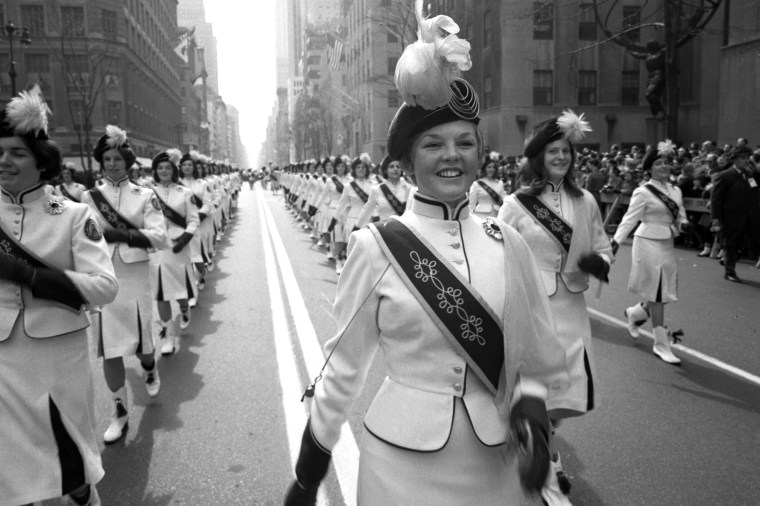On St. Patrick’s Day 1950, in a new suburban parish in the Archdiocese of Philadelphia, my mom and her “Irish twin” brother performed in a minstrel show. Granted, they were too young to be in blackface. But their names appeared the next day in the local newspaper along with the all-male chorus and makeup crew.
The performance was awash in nostalgia. Parishioners pined for a land that many in that church hall had never known, but feelings of displacement were also due to voluntary shifts. Postwar federal funding for white homeownership motivated many urban Catholics to abandon their city parishes and flock like a federally funded diaspora to neighborhoods in newly green-lined suburbs. Amid these changes, a dose of blackface minstrelsy reassured them of their white Americanness despite, or perhaps in addition to, their Irish Catholicity.
A dose of blackface minstrelsy reassured them of their white Americanness despite, or perhaps in addition to, their Irish Catholicity.
Ironically, I stumbled upon this unsettling tidbit of my family’s Irish Catholic American history while bracing to unearth another. I went looking for an advertisement my grandfather had likely placed for his new whites-only subdivision in suburban Philadelphia and found Mom in a minstrel show, instead. The two are not unrelated. Minstrel shows in Catholic parish halls allowed families like mine to stay tethered to a key part of our cultural identity as Irish American Catholics, especially in new suburban landscapes. My grandparents could defend their faith from Protestant anti-Catholicism by flipping America’s minstrelsy script, proving Americanness via their anti-Blackness. And they could defend their territory — parish, school and home — against Black Americans, whom many blamed for the downfall of beloved urban parishes.
Minstrelsy might not be part of church celebrations anymore, but white Irish American Catholics still get defensive about racism. We resort to familiar tropes like “my family didn’t own slaves” or “we were discriminated against, too,” or “all lives matter” to protect ourselves from the ugliness of the racism that has wrapped itself around many Irish Catholic family trees like a choke vine.
But there is a better way to celebrate the feast of St. Patrick in America, one that reconnects us solidly with those who long for freedom.
To start, on St. Patrick’s Day we could let go of feeling defensive or guilty about the racism in our Irish American Catholic history and simply tell the truth about it. Certainly, researching my own family has flipped over plenty of rocks. Some relatives lived in a city parish that records of the American Catholic Historical Society indicate was built on land bequeathed to the church by an Irish-born slave owner who had two enslaved people baptized while living there, while others kept their heads down in a rural parish less than 15 miles from the Mason-Dixon Line, while Black refugees of slavery were secreted by on the Underground Railroad. Some lived in predominantly Irish parishes that organized to keep Black families out, and some attended predominantly Irish Catholic colleges — like my current employer, La Salle — that were slow in letting Black students in.
The point of remembering this shadow side of Irish Catholic American history is not to blame and shame but to learn and grow. We cannot change what we cannot name, as the adage goes. Plus, if we remember the ugly we can also reclaim the beautiful white Irish American Catholic souls who defied conventions of anti-Blackness: the parishioners who refused to sign racial covenants, the white college students who insisted that Black lives matter before that became a mantra, my housing developer grandfather who paid into the family’s Black housekeeper’s Social Security even though he was not legally required to.
We could also celebrate the multicultural dimension of Irish American Catholicism. The African American Irish Diaspora Network believes that up to 40 percent of Black Americans could have some Irish roots. We can celebrate that Ireland’s Daniel O’Connell — “The Liberator” — supported Frederick Douglass' fight to end slavery. In fact, he reportedly called Douglass “The Black O'Connell.” This nugget is just one more reminder of Irish and Black America’s shared cultural roots in resistance movements. Maybe we add a little chard to our corned beef and cabbage; I learned from a fellow parishioner, a Black urban farmer with family roots in Mississippi, that we may need to expand our list of vegetables considered staples for “our” people here in America.
To be sure, some may bemoan sacrificing St. Patrick’s Day on the altar of “critical race theory.” A recalibrated celebration will need to incorporate some healing rituals, other than consuming alcohol and singing drinking songs. This course correction is necessary for a number of reasons. We all suffer when our remarkable cultural inheritance of agitating for the end of the caste system in Ireland gets reduced to green gimmicks.
My mom does not remember that 1950 minstrel show. Ignorance of the past does not excuse it. But as we must remember our past — both good and bad — let us also keep looking to the future. Let us transform the St. Patrick’s feast into an ongoing commitment to radical solidarity with all who sing freedom songs. Let us put those center stage.


